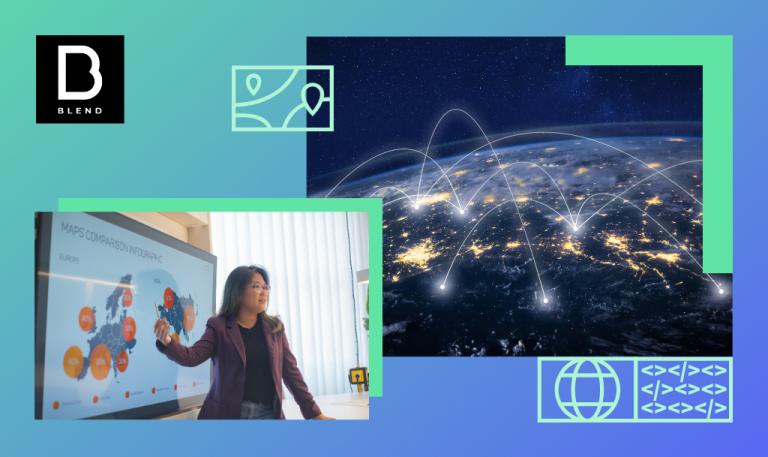Corinne Sharabi
Corinne is the Social Media and Content Lead at BLEND. She is dedicated to keeping global business professionals up to date on all things localization, translation, language and culture.


Global expansion is no longer reserved for enterprise giants. Today, companies of all sizes can go global—launching products, building communities, and scaling operations in markets around the world. But reaching global audiences requires more than a good product and a few translations. It takes a consistent, agile, and scalable localization strategy that’s where LangOps comes in.
LangOps, short for “Language Operations,” refers to the centralized management of language workflows across a business. It combines people, processes, and technology to streamline how multilingual content is created, translated, localized, and maintained across every department and customer touchpoint.
LangOps brings together localization managers, translators, AI tools, translation management systems (TMS), content management systems (CMS), project management platform and quality frameworks under one strategic umbrella. It’s not just about translating content faster—it’s about making localization a core business function that supports growth, customer satisfaction, and global agility.
In a world where customers expect native-like experiences—no matter where they live—localization is a business-critical function. But the traditional localization model isn’t built for speed or scale. Managing dozens of markets, channels, and content types quickly becomes overwhelming without the right infrastructure.
LangOps solves this by:
The result? A more efficient, aligned, and scalable localization strategy that evolves alongside your business.
Traditional localization often operates in silos. marketing does its own thing, product teams use separate translators, and support materials are updated on an ad hoc basis. This leads to inconsistencies, inefficiencies, and duplicated efforts.
LangOps flips the script by:
It’s the difference between everyone managing their own translation projects and having one connected, agile operation that serves the entire business.
A successful LangOps model brings together a few core elements:
This includes shared TMS platforms, translation memories, glossaries, and quality guidelines that everyone across the organization can access. It’s the foundation that keeps your brand consistent in every language.
LangOps works best when localization is integrated into every team—from marketing and product to sales and customer support. Shared workflows, centralized dashboards, and clear roles make this possible.
AI can handle speed and scale; humans ensure nuance and quality. LangOps combines the best of both through workflows like MT + post-editing, AI-powered quality estimation, and smart routing to linguists based on content type and priority.
LangOps is all about continuous improvement. Tracking metrics like translation speed, quality scores, and content performance in local markets helps teams refine their approach and demonstrate localization ROI.

At the end of the day, LangOps isn’t just about translation—it’s about making every customer feel like the product or service was built for them. From microcopy to onboarding flows, every word matters.
LangOps isn’t just a process improvement—it’s a growth enabler. Here’s how:
Automations and pre-approved workflows reduce localization bottlenecks so teams can launch campaigns, features, and updates faster in every language.
AI-assisted quality checks and centralized resources keep translations consistent and on-brand—even when you’re localizing high volumes of content.
By automating repetitive tasks and reusing content through translation memory, LangOps helps reduce spend without cutting corners on quality.
LangOps creates a shared language strategy across departments, helping teams work toward common goals.

If your business is growing internationally—or already serving global audiences—LangOps can help you scale smarter. It’s especially valuable for:
Even small teams can benefit from LangOps principles—especially when they’re managing a large number of markets or languages.
Here’s a snapshot of what a LangOps workflow might look like in practice:
It’s a scalable system that adapts as your business evolves.
At BLEND, we believe LangOps is the future of smart, scalable localization. That’s why we’ve built our platform to support every part of the LangOps journey. From AI-powered workflows to our global network of native linguists, our translation and multimedia localization services integrate directly with the platforms departments use to create and publish content.
Whether you’re translating support documentation, localizing a product interface, or adapting marketing campaigns across 20+ markets, BLEND helps you:
We work as an extension of your team, helping you build a localization operation that’s flexible, efficient, and ready for global scale.
LangOps starts with aligning your people, processes, and tools. Here’s how to begin:
With the right strategy, LangOps can transform localization from a cost center into a powerful growth driver.
Ready to scale smarter?
Talk to us at BLEND about how we can help you build a LangOps strategy that meets your business goals—no matter how many markets you’re targeting.
What our customers are saying